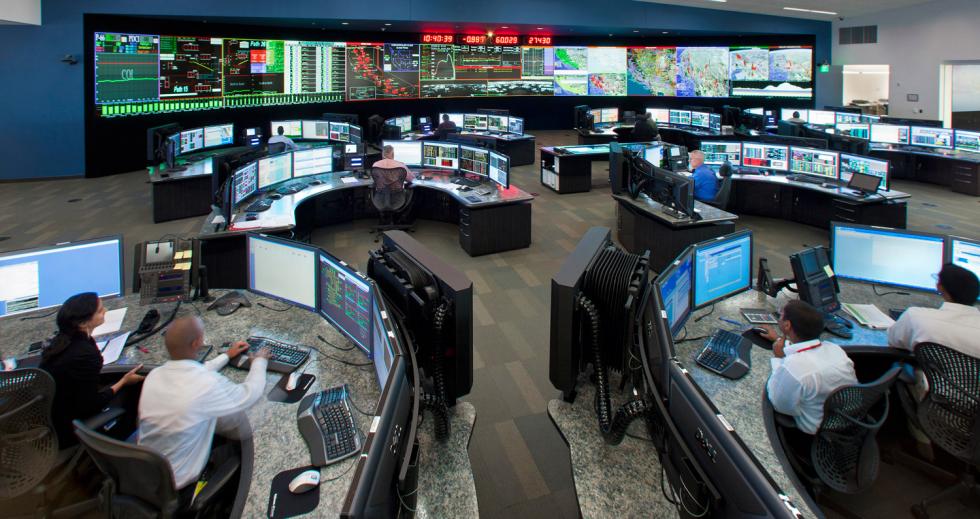Driving through the security-guard checkpoint to the massive 278,000-square-foot sleek building that emerges — not visible from the street — a visitor to the California Independent System Operator headquarters in Folsom would likely realize something important happens here before even stepping foot inside. And probably something environmentally significant, given the 34 spots for electric-vehicle charging stations outside.
Founded in 1997, Cal-ISO manages 80 percent of California’s electrical grid, as well part of Nevada’s. More precisely, they oversee the flow of electricity across the grid’s 25,865 circuit miles of high-voltage, long-distance power lines. This independent, nonprofit corporation lights the homes of 30 million Californians, and powers up our industries, hospitals, police stations, farms and retail businesses.
Cal-ISO also acts as an impartial grid operator, providing open access to the wholesale power market. They compare themselves to air-traffic controllers for high-voltage lines — not beholden to any one utility, and managing electron traffic on a power grid it doesn’t own. Cal-ISO is one of 38 balancing authorities in the western U.S., which maintain the balance of supply and demand. They do this by turning generators on or off, and importing or exporting excess electricity. Another example would be the Balancing Authority of Northern California, of which SMUD and Roseville Electric are part.
Related: Will the Mega-Grid Get Built?
About 575 employees work in the building, not including contractors or employees at Cal-ISO’s second site in Southern California (which will relocate to Lincoln later this year), says Thomas Cuccia, a Cal-ISO policy specialist, as we walk toward the centerpiece of the facility: the control room.
In this room, a team of transmission operators, generation operators, IT system engineers, shift supervisors, schedulers and market operators are busy at work. These employees — who work 12-hour shifts — have gone through extensive training, testing and certification to obtain a spot on the floor, where they sit behind large U-shaped desks covered with several computers. And their education is ongoing; there’s a simulation-training room for disaster scenarios. “I don’t know if you’re a ‘Star Trek’ fan, but it’s the ‘Kobayashi Maru,’” Cuccia says, before explaining this reference to a fictional test for Starfleet cadets. “It’s the no-win situation, and how to keep things going, like if all the power went out.”
The control room of Cal-ISO in Folsom where 80 percent of
California’s electrical grid is managed. (Photo courtesy of
Cal-ISO)

The control room faces a large video wall measuring 6.5-feet tall and 80-feet long with 10 programmable screens. On the left side, screens depict transmission lines, which can be impacted by all sorts of activities, such as wildfires. Two devices, like “giant iPads,” with Google Earth have all their facilities mapped out, so if a fire strikes, they can identify the location and analyze wind speed and smoke, and decide whether to shut a line down. “We deal with [wildfires] more than any other catastrophe,” Cuccia says.
When a wildfire gets too hot, it can trip transmission lines out of service. Transmission lines are built to sag because they’re sensitive to heat, but if they sag too much, the electricity can’t navigate the line and the line collapses. “Smoke from wildfires is also very hot and carries embers, which can force a line out of service,” explains Steven Greenlee, a Cal-ISO public information officer. “However, we will turn off a line if it is under immediate threat from a wildfire and before it trips off line.”
Related: Infographic: More and More Renewables Coming Online
The middle screens deal with reliability, and the screens on the right involve generation and forecasting. There’s also the BAAL screen — for Balancing Authority ACE Limit — showing a green ball that must stay inside two red bands, which means Cal-ISO is hitting its 60-hertz voltage target. Cal-ISO has thousands of resources that generate electricity (“We’re adding solar every business day,” Cuccia says), and different resources have different impacts; solar and wind, for example, can adversely impact the grid because their output is variable and volatile (state mandates require the use of more and more renewables). The ideal is a calm, steady level of voltage to help maintain a stable, reliable grid. Excess energy poses a problem. Think of a power surge in your house.
If the ball goes outside either band, Cal-ISO has 30 minutes to fix the problem or it’s susceptible to penalties. From time to time, the ball exits the bands, especially in the off-season like spring or fall when there’s lots of solar but people aren’t turning their air conditioning on, which results in too much generation.
In the middle of the wall is a monitor with headline news, in case something occurs that affects the grid — say a wildfire, earthquake or terrorist attack. The state’s historic drought has significantly impacted Cal-ISO, by reducing the availability of hydroelectricity. Folsom Lake is almost at full capacity and El Niño was “decent,” Cuccia says, but they still planned for less available hydro for this year.
Cal-ISO’s impressive exterior indicates the importance of the work done inside. Most of us will never see the facility’s control room, but we should think of this place — and the people hard at work within it — whenever we turn a light on, put food in a refrigerator, charge a laptop, watch a movie or work out at the gym. Because grid operators like Cal-ISO impact most aspects of our daily lives, whether we realize it or not.




Comments
The article is good and informative, but the author mixes up voltage and frequency. The problem that is described with the excess energy, is frequency, not voltage as the author says.
What is the area of the control room?
I would like to know the dimensions of the Control Room (WxL) and how many operators accomodate.
Thanks